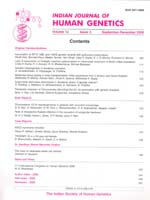
|
Indian Journal of Human Genetics
Medknow Publications on behalf of Indian Society of Human Genetics
ISSN: 0971-6866 EISSN: 1998-362x
Vol. 9, Num. 2, 2003, pp. 74-75
|
Indian Journal of Human Genetics, Vol. 9, No. 2, July-Dec, 2003, pp. 74-75
The Fourth European Cytogenetics Conference, Italy
Sept. 2003: A report
Prochi F. Madon
Consultant in Genetics, Department of Assisted Reproduction and Genetics,
Reliance Life Sciences, Mumbai - 400004, India; and Jaslok Hospital & Research
Centre, Mumbai - 400026, India.
Code Number: hg03015
The Fourth European Cytogenetics Conference (FECC) was held in
Bologna, Italy, from Sept. 6 - 9, 2003. The theme of the conference was `Cytogenetics
in the post-genomic era.' It was attended by many well known cytogeneticists.
The red inaugural was in the majestic Europa Auditorium fully furnished in
red. Professor Eric Engel, pioneer of the concept of uniparental disomy (UPD),
gave the honorary lecture. It was amazing to see how mentally alert a person
way past retirement age and hard of hearing can be! He started right from the
days when his paper on UPD was rejected by leading journal because of this
revolutionary concept.
As is well known now, many disorders are caused because an
individual inherits both homologues of a chromosome form a single parent. The
classic example is Prader-Willi syndrome where both copies of chromosome 15
are inherited from the mother. Uniparental holodisomy (for the whole of a pair)
is now known for 18 maternal and 14 paternal pairs and is mainly cause by `trisomy
rescue' (correction of a trisomy). The role of chromosomal imprinting, a secondary
(epigenetic) reversible change of gene expression as a function of transmission
from the maternal or paternal parent has been affirmed through cases of UPD.
Uniparental merodisomy (partial UPD) is probably caused by balanced somatic
recombination (chromatid kiss) between homologous strands. UPD has also been
observed in the euploid line of a mosaic trisomy (incomplete trisomy rescue),
explaining Rh+/Rh- and other blood group mosaicisms. A breach from Mendelian
inheritance (non-traditional inheritance) has been observed in atleast 27 conditions
including cystic fibrosis.
Some cases of fetal demise, abortions particularly in older women
and loss of heterozygosity (LOH) leading to cancer have also been attributed
to UPD. Dr. Engel got well deserved words of praise from Lidia Larizza and
Albert Schinzl.
Other renowned speakers included Eichler (origin and impact
of segmental duplications), Zuffardi (chromosome rearrangements), Fryns (behavioural
phenotypes), Felix Mitelman (cytogenetics in epithelial tumors), Yuri Verlinsky
(PGD), Stuppia (male infertility), Schwab (fragile sites), Mariano Rocchi (molecular
cytogenetics), Kramer (centrosome aberrations and cancer development), Cremer
(chromosome structure, function and interphase nucleus studies) and Carter
(DNA microarrrays). The Abbott Satellite Symposium was on `Genetic testing
in pre-and postnatal diagnostics: Clinical practice and future trends.' The
speakers were David Ledbetter (Array CGH), Luca Gianaroli (clinical aspects
of preimplantation genetic diagnosis- PGD), Cristina Magli (technical aspects
of PGD), Andreas Plesch (automated FISH analysis) and Glaubiz (FISH analysis
- 10,000 samples).
A lot of knowledge was gained by attending the conference. The numerous poster
presentations gave a lot of information on the current status of cytogenetics
worldwide. The abstracts are published in Abbales de Genetique, 4:2 _ 3, Sept.,
2003. They are also diplayed on the website: .
The sponsoring companies had stalls that gave an idea of the numerous advances
in cytogenetics, especially image analysis and newer molecular techniques like
CGH and microarrays. The official dinner was in the historic area of Bologna
with cobbled streets at the
Palazzo Isolani. The splendour of the olden days is
still maintained here.
Our abstract `45,X,t(Y;13)(q11.2;q11), -der (13) with Y microdeletions
in an azoospermic male' was one of the few selected for oral communication,
and was well appreciated. This was a case of a couple married since 16 years
with a history of primary infertility. Testicular biopsy done earlier showed
complete maturation arrest. The karyotype on first impression was 45,X. As
this was improbable, we carried out interphase FISH, using Vysis centromeric
probes for X,Y and 18. The centromere of the Chromosome was present in all
cells. Sequential FISH on previously G-banded metaphases was then carried out
and the centromere of the Y chromosome was found to be located at the centromeric
region of on
homologue of chromosome 13. Closer examination
of G-banded karyotypes, revealed a very small
increase in the length of the short arm of chromosome 13,
which was not noticed earlier. This was therefore a case of
a Y/13 translocation. The derivative 13 (13
pter → 13q11::Yq11.2 → qter) was lost and did not have any clinical
consequence except azoospermia. Only the part of the Y chromosome which is essential
for
development of a male *Y pter → Y q11.2) was
translocated to chromosome 13. Y microdeletion detection analysis by multiplex
PCR (Promega,
version 1.1)
showed a deletion of 16/18 STSs from all the AZF regions. The only 2 loci not
deleted were DYS215 and DYS223 in the AZFb region. The couple agreed to assisted
reproduction
using donor sperm.
Copyright 2003 - the Indian Society of Human Genetics
|
